Anyone starting out riding a bike in Taiwan is inclined to head for the east coast, and with good reason. From Yilan down to Pingtung you are riding next to the Pacific Ocean and with a lower population density fewer cars are encountered. If I had to choose I would advise a south to north ride on Provincial Highway 11 with the coast on the right hand side — that of course would be during the summer months with prevailing tail winds.
But there is much more to the east of Taiwan than the coast road. The other primary road is Provincial Highway 9. As the main conduit connecting Taitung and Hualien it gets a lot more traffic, and so I tend to avoid it.
On a recent ride I was in the Taitung area on a four-day trip with the sole object of connecting some of the lesser explored roads of the coastal mountains. Known as an Emerald Paradise, the East Rift Valley (花東縱谷) is a maze of quiet country roads that few people explore. It is no surprise that it was voted by Taiwanese as their favorite part of the island. This is bread basket country, with an abundance of fields growing fruit, vegetables and rice.
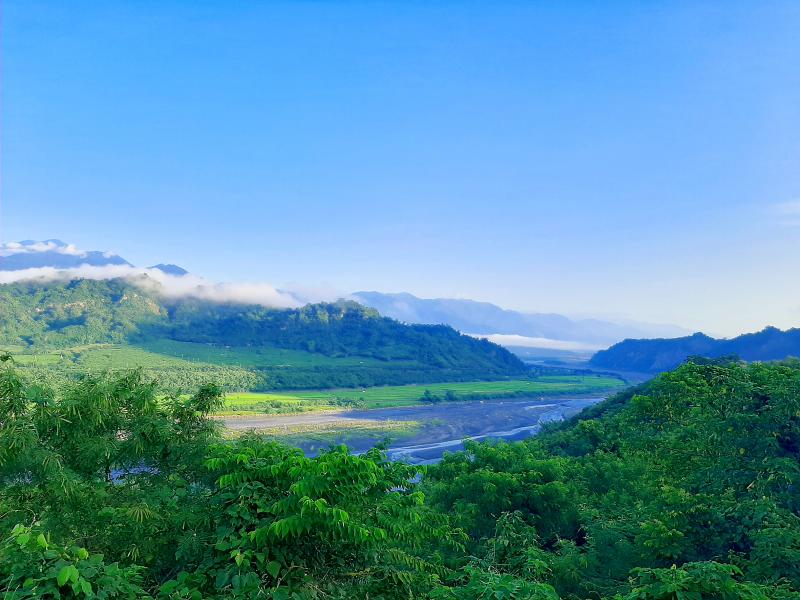
Photo: Mark Roche
I started from Kaohsiung on a Thursday evening, taking the train off-peak to avoid crowds. For this trip I was riding a gravel/touring bike — basically, a road bike that is capable of dealing with rough roads, fitted with wider tires than a road bike that can carry camping and other gear for a multi-day trip.
After the 2-hour train ride, I had my bike set up and on the road at 8.30pm. It’s just a 5km ride to the start of County Road No. 197 (縣道197) , which is 59km long and traverses from Taitung city to Chihshang Township (池上). I camped at a pavilion 10km up this road. For the most part there is very little traffic, but it is popular with Taitung residents who drive up to see the night view over the city.
OLD COUNTRY ROADS
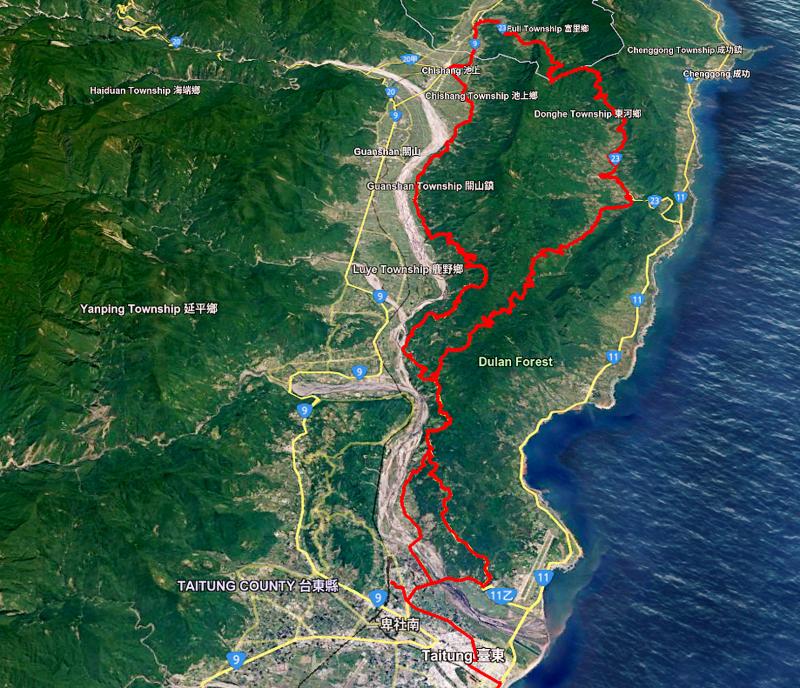
Photo courtesy of Nathan Miller
The following morning the real ride began. Continuing north on County Road No. 197 there is a small village called Jungshan (榕山) at the 43.5km marker. Turn right here onto the Tung 40 (東40), which connects approximately 13km later to the Tung 23 (東23).
This is basically the middle of nowhere. After a fairly steep climb up for several kilometers and a few hundred meters’ elevation gain, there is a feeling of being transported to another world. Apart from a few small villages this is 30km of joy riding. This is the first, but not the least part of the trilogy of roads that access parts of Taiwan very few, if any, tourists visit. After riding this road, the first crossing of the coastal mountains on a north/ north-east heading in the direction of the east coast is completed.
The Tung 23 ends at Taiyuan village (泰源村), which has a more substantial population where supplies can be picked up. It was an extremely hot weekend in September doing this with a fully loaded bike, but there wasn’t time to rest since the biggest climb of the trip was in front of me.
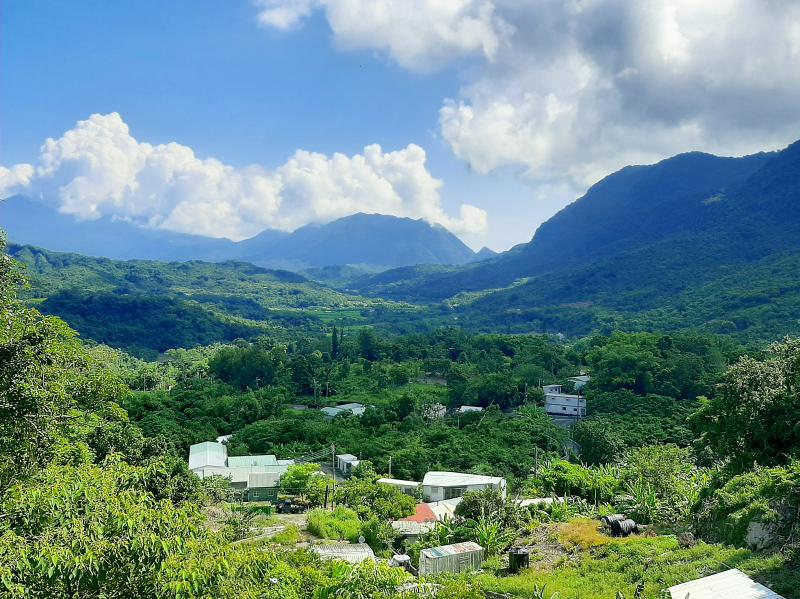
Photo: Mark Roche
Provincial Highway No. 23 runs north-west from here to the second crossing of the coastal mountains. Again, this road is a cyclists dream ride ascending several hundred meters and offering views of pristine forest, undulating hills and an abundance of wild life. It was difficult to appreciate on this particular day as I was sweating profusely. Heat exhaustion is almost a certainty riding through the summer and early autumn months, so knowing when to stop and cool off is the difference between heat exhaustion and heat stroke.
Once over the climb the road rolls down to Fuli township (富里鄉) in Hualien and a 7-11 to stock up — I needed a beer reward. I finished the day by riding about 10km down Provincial Highway No. 9 to Chihshang (池上). I mentioned earlier that County Road No. 197 starts from here and ends in Taitung. This is the third and final part of the trilogy. I spent the night at a small village shrine. Fitted with a sink and running water I was able to have an al fresco wash down.
Instead or repeating the first day ride I took an alternative route back to the city. At the 50km marker on County Road No. 197 there is a turn off for the Tung 45. Apart from avoiding repetition the Tung 45 passes the Lichi Badlands (利吉惡地) a popular tourist attraction known to geologists as the “Liji (or Lichi) melange.” The moon-like landscape is well worth the stop for a photograph. This road connects almost directly back to Taitung train station to finish.
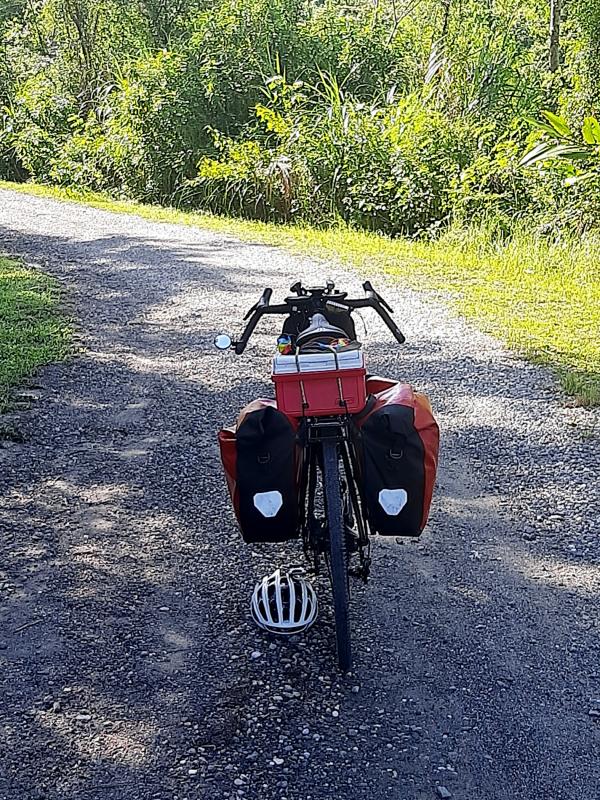
Photo: Mark Roche
PRACTICAL CONSIDERATIONS
Out on these multi-day rides I generally bed down at around 9pm in order to get up to enjoy the sunrise when it’s cooler. Day 3, and the final part of the trilogy, is riding County Road No. 197 through to Taitung. This is, in some ways, the most interesting part of the ride. Although there is a perfect surface for most of this road, for some unknown reason there is a 14km gravel section starting from the 23km marker to the 37km marker, which as far as I know has never been properly surfaced, which means that using a regular road bike can cause serious injury. County Road No. 197 is a popular training road for cyclists living in Taitung, but only up to the 37km marker gravel section.
I stretched this out over a few days with a touring/camping set up, but there is no reason why it can’t be done as a single ride. Door to door from Taitung train station the trilogy of County Road No. 197, Tung 23, Provincial Highway 23 and back to County Road No. 197 was a total of 158km with an elevation gain of 2,600m.
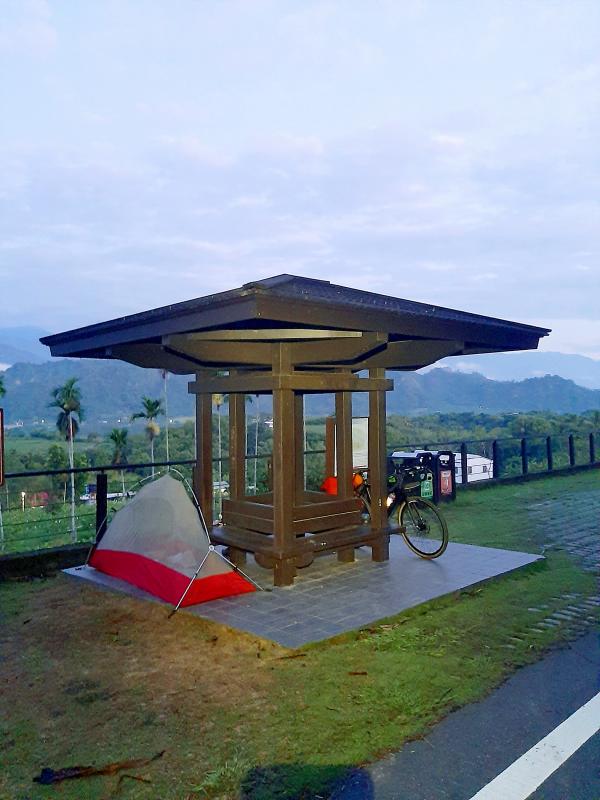
Photo: Mark Roche

In the next few months tough decisions will need to be made by the Taiwan People’s Party (TPP) and their pan-blue allies in the Chinese Nationalist Party (KMT). It will reveal just how real their alliance is with actual power at stake. Party founder Ko Wen-je (柯文哲) faced these tough questions, which we explored in part one of this series, “Ko Wen-je, the KMT’s prickly ally,” (Aug. 16, page 12). Ko was open to cooperation, but on his terms. He openly fretted about being “swallowed up” by the KMT, and was keenly aware of the experience of the People’s First Party

Aug. 25 to Aug. 31 Although Mr. Lin (林) had been married to his Japanese wife for a decade, their union was never legally recognized — and even their daughter was officially deemed illegitimate. During the first half of Japanese rule in Taiwan, only marriages between Japanese men and Taiwanese women were valid, unless the Taiwanese husband formally joined a Japanese household. In 1920, Lin took his frustrations directly to the Ministry of Home Affairs: “Since Japan took possession of Taiwan, we have obeyed the government’s directives and committed ourselves to breaking old Qing-era customs. Yet ... our marriages remain unrecognized,

Not long into Mistress Dispeller, a quietly jaw-dropping new documentary from director Elizabeth Lo, the film’s eponymous character lays out her thesis for ridding marriages of troublesome extra lovers. “When someone becomes a mistress,” she says, “it’s because they feel they don’t deserve complete love. She’s the one who needs our help the most.” Wang Zhenxi, a mistress dispeller based in north-central China’s Henan province, is one of a growing number of self-styled professionals who earn a living by intervening in people’s marriages — to “dispel” them of intruders. “I was looking for a love story set in China,” says Lo,

During the Metal Ages, prior to the arrival of the Dutch and Chinese, a great shift took place in indigenous material culture. Glass and agate beads, introduced after 400BC, completely replaced Taiwanese nephrite (jade) as the ornamental materials of choice, anthropologist Liu Jiun-Yu (劉俊昱) of the University of Washington wrote in a 2023 article. He added of the island’s modern indigenous peoples: “They are the descendants of prehistoric Formosans but have no nephrite-using cultures.” Moderns squint at that dynamic era of trade and cultural change through the mutually supporting lenses of later settler-colonialism and imperial power, which treated the indigenous as